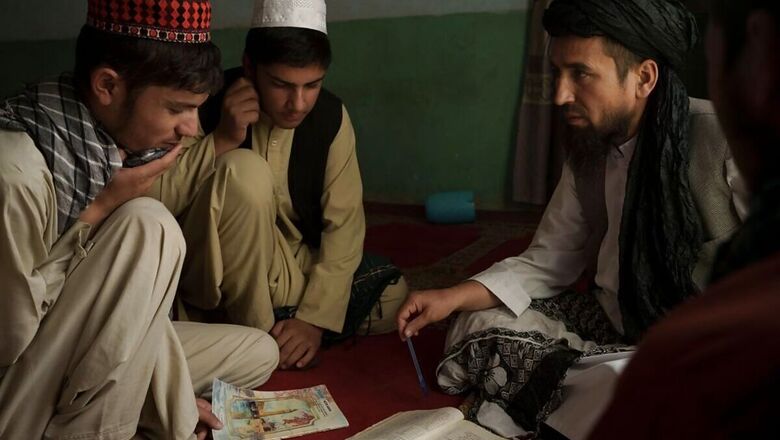
views
From celebrating Direct Action Day as “Muslims League’s street power”, labelling Hindus as “extremists” and blaming them for driving Muslims away, to accusations of bias: the class 11 and 12 history books in Pakistan are full of anti-Hindu references and distorted historical facts. News18 has accessed these books published by the Federal Textbook Board of Islamabad that reveal how India and Hindus per se have been depicted in a poor light.
Chapter one of the textbook Pakistan Studies for classes 11 and 12 titled ‘Genesis of the Islamic Republic of Pakistan’, the ‘Two-nation Theory’ has been defined as one based on the principle that the Muslims and non-Muslims in India were separate and distinct nations.
The subhead on fundamental human rights talks about two types of Hindu leadership in Southeast Asia — extremists and moderates. The textbook elaborates: “The Congress was fully overpowered by the extremists at the juncture of history when the British had decided to transfer power to the Indian hands. In this state of affairs, the Muslims and the other minority communities in the region started feeling that if the Indian government is entrusted to the extremist Hindu hands they will deprive the non-Hindus of their most fundamental rights. This feeling served as a strong motive force behind the Muslim demand for Pakistan, and for the same reason, the non-Muslims of this region rendered full support to the Muslim demand for Pakistan.”
Under the head ‘Pakistan: The Outcome of Sustained Muslim Efforts (landmark events)’, the textbook alleges, “Anti-Muslim movement Arya Samaj flourished in the last two decades of the nineteenth century. The movement aimed at reconverting the Muslims to Hinduism. Bankim Chandra Chatterji wrote a novel ‘Anand Math’ which provoked Muslims’ religious sentiments. Anti-Muslim epic Bande Mataram was a part of this novel.”
At another point, the book again accuses Hindus of trying to convert Muslims. “Hindu extremists started programmes like the ‘Arya Samaj’ with a purpose to reconvert the Muslims into Hindu religion. Hindu writers spread hatred against the Muslims among their followers.”
According to education experts, the content being taught in the textbooks is not just distorted but even creates a false perception of India in young minds. School textbooks, especially, cannot have such enmity-ridden content, they say.
Prof H Senapty, who works at NCERT’s regional wing at Bhubenashwar, said history books for any nation or society cannot show any other nation, religion or its people in a negative light. It has to be just facts and their elaboration, without any exaggeration.
“In India our approach to developing school curriculum is clear cut to be objective. Especially, textbook content on sensitive issues such as Kashmir or partition has to be entirely just on facts, without drawing any interpretations.”
The chapter on ‘Partition of Bengal in 1905’ again wrongly says that Hindus and the Indian National Congress (INC) opposed the partition since it benefitted Muslims. “In the year 1905 Lord Curzon partitioned Bengal into two parts, i.e., East Bengal and West Bengal. This step was taken mainly due to administrative reasons. Since this partition benefited the Muslims, the Hindus and the Indian National Congress opposed it vehemently.”
Notably, the text highlights ‘Direct Action Day’, when a large number of Hindus were killed in Calcutta after the Muslim League targeted its political opponents, as one where “Muslim League demonstrates its street power (August 16, 1946)”.
This is not all. The book also indirectly blames the Congress and the Hindus for the communal violence. Sample this: “The Viceroy should have invited the Muslim League to form government after Congress’s refusal but he failed to keep his promise…Although the Congress had not accepted the Cabinet Mission; yet on August 12, 1946 the Viceroy, invited Pandit Nehru to form interim government. Protesting on this, the Muslim League called on the Muslims to celebrate 16th of August as the Direct Action Day…The appeal proved very effective, the Muslims expressed their resentment through protest rallies. The Hindus retaliated by attacking them. Thousands of people were killed in Calcutta in Hindu-Muslim clashes. Within no time the whole of India was taken over by communal frenzy.”
The text again accuses the INC of bias against Muslims. “Congress and the allied parties were able to form governments in seven out of the eleven Indian provinces; these governments set a record of bad governance and partiality against the Muslims,” it reads.
Labelling Hindus as “extremists” at every opportunity, the textbook accuses them of driving Muslims away. “The Muslims had lived with the Hindus as neighbours and compatriots for about one thousand years. On the basis of their experience they could not expect good neighbourly treatment from the extremist Hindus, who had already made it clear that the Muslims had no place in India, they should either embrace Hinduism or quit India,” the book reads.
Even post-partition problems of Pakistan have been blamed on India, accusing it of bias. “Partition was conducted in a way which manifested naked bias and injustice towards the Muslims…Results of the injustices done in the Partition: The Kashmir Issue. First seeds of the Kashmir problems were sown by the Radcliffe Award. Inclusion of Gurdaspur gave India an access to Kashmir, the only land routes that connected India with Kashmir passed through Pathankot, a Tehsil of district Gurdaspur. If Gurdaspur were not made part of India there would be no land access for India to reach Kashmir.”
It goes on to blame India for withholding “Pakistan’s share of stationery items and office equipment”. The chapter further reads: “The Hindu functionaries spoiled the office record before leaving Pakistan. The Indian government gave Pakistan only a small part of her share in the military assets, even that was not in working condition. Thus, Pakistan started its new life with a small military force having absolutely meagre resources.”
Read all the Latest India News here


















Comments
0 comment